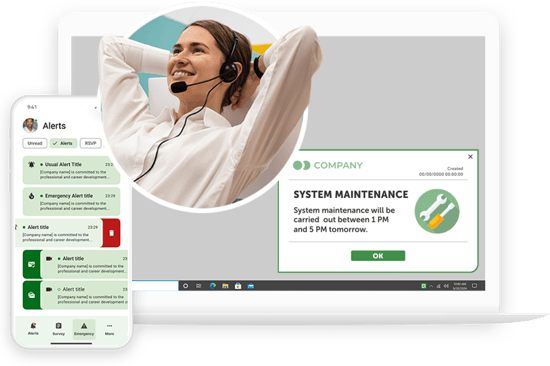Elevate Your Workplace Communications with DeskAlerts Software
Broadcast alerts seamlessly to all corporate devices - PCs, phones, tablets, and more. High visibility and 100% readership assurance means you never miss a reader again.


70% Faster
Incident Response

70% Increase
in Employee Interaction
Alert Employees Quickly in An Emergency
When there's an emergency situation affecting your employees, send critical information instantly with DeskAlerts emergency software
- Real-time information can be sent in seconds
- Get instant feedback to confirm employee safety
- Use multichannel notifications to increase visibility

Reduce Pressure on Your IT Helpdesk
Effortlessly provide real-time updates on system outages or planned maintenance and reduce the influx of calls to the Helpdesk.
- Send notifications about outages via user-friendly pop-up alerts
- Run education campaigns on the most common IT challenges
- Enhance cyber security by sending quizzes to test employees' knowledge

Drive Engagement and Performance
Cut through the digital noise in your workplace, overcome email fatigue and engage directly with employees.
- Ensure accountability through acknowledgments
- Enhance performance with transparent communication
- Gather critical feedback through surveys

A Wide Range of Communication Channels
Seamlessly Integrates with Your Other Tech Tools
Integrate DeskAlerts seamlessly with your existing tools, automating the display and sharing of content. Save valuable time, streamline your workflows and effortlessly deliver pertinent information to keep your employees consistently informed.

Efficient Information Management
Instant creation, editing, and delivery

Urgent Alerts
Send urgent notifications instantly to keep your employees safe in an emergency situation using a range of features designed to help save lives.

Color Codes
Use color codes to standardize communication, swiftly manage emergencies, and enhance safety through distinct, universally understood signals that ensure timely and precise action.

Targeting
By using Active Directory Integration you can target who you send alerts to such as specific departments, groups or even individual users.

Send Multimedia
DeskAlerts lets you send video through YouTube and Vimeo with embeddable URLs or send videos directly recorded on your desktop webcam. You can also send images in .jpg, .png, .gif and .bmp format or HTML links.

Extended Statistics
Track message delivery down to specific users and devices to determine who has seen your messages. Create charts or export data to a CSV file.

System Integration
DeskAlerts integrates easily with existing IT and emergency warning systems and can be used to connect to just about any device. Compatible with Windows, Mac, Android and iOS devices it can also be paired with SharePoint, XenApp, Outlook etc.
Deliver Key Information to Any Device or Location
Keep in touch with users who are in different locations and no matter what type of device they're using

Send Key Messages to Any Location
If your company operates in different locations, countries, cultures, languages and time-zones you can send targeted notifications that reflect this.
No matter where your employees are located in the world they can stay informed and be kept up-to-date with your important announcements.
Especially usefull for enterprise-level communication.

Send Alerts to Different Devices
Quickly and easily send alerts about important issues to employees no matter what device type they are using. DeskAlerts is compatible with Windows, Mac, Android & iOS.
You can use different features to reach people on different devices such as desktop alerts, push notifications to mobile devices, digital signage, SMS and email messages.
Professional Services
- Onboarding
- Training services
- Implementation service
- Data control & Infrastructure configuration
- Third party software integration

Join The Millions Who Trust DeskAlerts






Decrease Calls to Helpdesk
“DeskAlerts gave our company a tool to instantly inform users about all types of events. It was easy to configure and deploy and has helped to decrease the call volume to our helpdesk.”
Juan C Rosique
Corporate Information Technology, Masanutteng Resort

Instantly Share Critical Updates
“We have information monitors in several locations throughout our building where we broadcast system alerts and other important information that affect our peoples’ daily work.”
Bo B. Jørgensen
Service Desk, Topdanmark

Ensure Message Visisbility with Pop-ups
“Whether its notifying about a delay to a meeting start time or a reminder that its time to head out for a team lunch, desk alert software pop up messages on screen and action is taken by employees.”
Fern Schweitzer
Network-Services Specialist, Info Tech, Inc.

Communicate Across Geographic Regions
“The perfect choice for a company needing a centralized alert solution spread across different locations. We use it to inform in-store labs in retail sites across Australia and New Zealand about updates and issues.”







